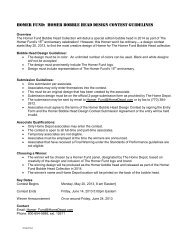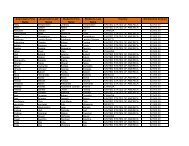Working With Checking and Savings Accounts - The Homer Fund
Working With Checking and Savings Accounts - The Homer Fund
Working With Checking and Savings Accounts - The Homer Fund
Create successful ePaper yourself
Turn your PDF publications into a flip-book with our unique Google optimized e-Paper software.
Endorsing a Check<br />
Endorsing a check is signing the back of a check that is made out to you to release the<br />
funds. You will need to endorse all checks that you deposit. You should sign your<br />
name exactly as it is listed on the front of the check. <strong>The</strong>re is a designated space for<br />
your signature on the back of all checks. <strong>The</strong>re are three types of endorsements:<br />
Blank endorsements: This is when<br />
you sign the back of the check <strong>and</strong><br />
provide no instructions. Once you<br />
have signed the back, anyone can<br />
cash the check.<br />
Specific endorsements: This is when you<br />
identify a purpose for the check (i.e.,<br />
“deposit only”). It is a good idea to<br />
use this type of endorsement when<br />
you are depositing a check—especially<br />
if you are using an ATM.<br />
ENDORSE HERE<br />
X<br />
Lucas Chapel<br />
ENDORSE HERE<br />
X<br />
Lucas Chapel<br />
For deposit only<br />
DO NOT WRITE, STAMP OR SIGN<br />
BELOW THIS LINE.<br />
RESERVED FOR FINANCIAL<br />
INSTITUTION USE<br />
DO NOT WRITE, STAMP OR SIGN<br />
BELOW THIS LINE.<br />
RESERVED FOR FINANCIAL<br />
INSTITUTION USE<br />
ENDORSE HERE<br />
X<br />
Pay to the order of<br />
Patrick Brown<br />
Lucas Chapel<br />
Patrick Brown<br />
DO NOT WRITE, STAMP OR SIGN<br />
BELOW THIS LINE.<br />
RESERVED FOR FINANCIAL<br />
INSTITUTION USE<br />
Two-party checks/transfer endorsements: This is<br />
when you transfer a check that has been<br />
written to you to another person. After you<br />
endorse a check, only the person who is<br />
named in the endorsement can cash or<br />
deposit the check (i.e., Pay to the order of<br />
Patrick Brown). In this example, Patrick Brown<br />
will be asked to sign the back of the check <strong>and</strong><br />
possibly show I.D. when he cashes or<br />
deposits the check. A check can only be<br />
transferred to one other party. <strong>The</strong>refore, (in<br />
this example) Patrick Brown must cash the<br />
check.<br />
11







